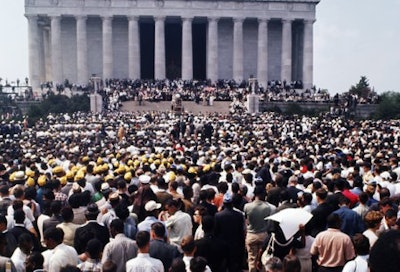
Frank Bond, a broadcast journalist and producer at the Newseum, recalled that there was great anxiety and fear among the media and John F. Kennedy’s administration that the march would turn violent.
“Everyone wanted to know, ‘Is there going to be a blood bath on the mall,” said Bond, who noted that most of the White daily newspapers noted in their coverage that the event went off without incident while most of the Black weeklies were upbeat by the events of that day.
Although the march has largely been associated with the “I Have a Dream” speech delivered by Dr. Martin Luther King Jr., he was not the only speaker to address the 250,000 people who assembled at the Lincoln memorial that sweltering, hot August day.
Dr. Kirt Wilson, an associate professor of communication arts and sciences at Pennsylvania State University, pointed out that there were 10 speakers—including John Lewis and A. Philip Randolph—who stirred the crowd that day. Still, the retelling of that day often begins and ends with King’s speech. That’s unfortunate said Dr. Carole Blair, who noted that the march and the overall Civil Rights Movement involved the individual sacrifices made by “obscure ordinary people.”
Richard Prince remembers the march. He was a senior in high school when he and his family traveled by bus from Long Island to attend. And though he left before King delivered his speech, Prince said there were some early concerns by the organizers that more Whites than Blacks would show up at the event.
“Black journalists talk about feeling a great pride from covering the event,” said Prince, who writes a blog about diversity issues. In the years since the march, he noted that some mainstream White publications that advanced a “southern White point of view” have since apologized for their slanted coverage or their decision, in some instances, not to cover the march or the Civil Rights Movement at all.
“The networks were not universally sympathetic to the Civil Rights Movement either,” Prince said, adding that broadcast journalist Chet Huntley once blasted the NAACP on air as an extremist group.
Dr. Catherine Squires, an associate professor of mass communications at the University of Minnesota, said most Americans do not know that the original focus of the march was to train a public spotlight on the need for jobs.
“The jobs part so frequently falls out of that calculus,” said Squires, who pointed out that the presence of Randolph—a Black labor leader who was chiefly responsible for organizing the march—was not a mere coincidence. “The movement was not just about being able to enter public accommodations, but to make enough money to spend in these places,” she said.
In praising his “I Have a Speech,” Dr. Carole Blair, a professor of communication studies at the University of North Carolina at Chapel Hill, said that the overall public also tends to overlook or dismiss King’s fierce critique of poverty and the Vietnam War during the latter years of his life. “This is the King that people find more dangerous and less comforting,” said Blair. “As great of a speech, and brilliant as it is, we lose the King from 1964 to 1968.”
The need, panelists emphasized, is for young people—namely, college students—to discover King’s radical politics.
“We are all disheartened by how much the backlash has become apparent, not even subtle,” said Squires, pointing to the U.S. Supreme Court’s decision to strike down parts of the Voting Rights Act.
The panel discussion was jointly sponsored by the National Communication Association and the Newseum—an interactive museum of news and journalism that opened in 1997. Gene Policinski, chief operating officer for the museum, said that a new exhibit, “Make Some Noise: Students of the Civil Rights Movement,” is scheduled to debut on August 2, 2013.
Meanwhile, for more information on the upcoming march scheduled to take place on August 24, 2013, in Washington, D.C., visit www.nationalactionnetwork.net


















